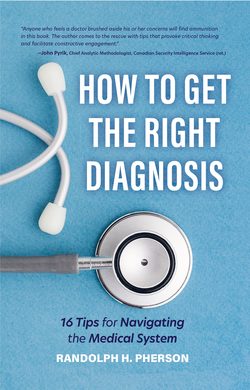Читать книгу How to Get the Right Diagnosis - Randolph H. Pherson - Страница 12
На сайте Литреса книга снята с продажи.
ОглавлениеChapter 1
An Undiagnosed Illness
For thirty-five years, I have belonged to a club that runs five miles cross-country over new territory once a week. Thirty to forty of us gather each week without fail. Since joining the club, I have completed over 1,350 five-mile runs. I also ran five Marine Corps Marathons in Washington, DC, recording a best time of three hours and forty-five minutes.
For the first twenty-five years, I had little difficulty keeping up with the pack. Beginning in 2008, however, I started to slow down. I found myself trailing behind. Soon it became obvious that I had become a solid member of an elite group our club calls the “Big behind.”
By 2009, I had become frustrated. After running twenty to thirty minutes, I found that my lungs would start to ache. I had to walk to catch my breath before resuming the run. It felt like my lungs could take in only a certain amount of oxygen, and I was forcing them to do more than they could manage. If I pushed too hard, trying to “run through the problem,” I would feel a little numbness in my fingers and a slight ache in my upper chest—but nothing serious.
Self-Diagnosis
Could I simply be out of shape? I exercised six days a week. My routine was to run once a week, use an elliptical trainer twice a week (pushing my heart rate to 120–130), and lift weights for forty-five minutes the other three days. I also thought the problem might be that I was overweight. I continued exercising, reduced my food intake, and lost fifteen pounds. Unfortunately, none of these actions made any difference.
I mentioned my frustrations to my family doctor, and we speculated on what could be the problem. Northern Virginia has a high incidence of people with asthma and allergies, so I wondered if that could be the issue. Seasonal allergies were an unlikely cause because my breathing problems were not related to the time of year. I travel frequently and usually enjoy an early morning run in the various cities I visit. In recent years, I had stopped running outside when traveling because running was becoming too strenuous for me.
Is It My Heart?
In 2010, my family doctor and I decided to take more aggressive action. She arranged in February for me to undergo a cardiac treadmill stress test with radioactive fluids to observe the condition of my heart. I underwent testing at a highly credentialed hospital in Northern Virginia with a sterling reputation for dealing with heart disease. A team of three cardiologists reviewed the tests and told me I had scored far above the norm. In March, I did another treadmill test using the Bruce protocol—a maximal exercise test where the patient works to complete exhaustion running on a treadmill as the speed and incline are increased every three minutes. Following the test, the junior doctor on the team thought I could have a problem not getting enough blood to my heart. He suggested I might be a candidate to have a stent inserted into one of my arteries.
The cardiac team decided that I should undergo another test that takes a picture of my beating heart. In December, I had an Echo 20 PW Spectral Doppler heart exam that revealed no significant problems with my heart muscle. The test showed my heart was in good condition—a fact they attributed, in part, to my history as a runner. Once the tests concluded, the senior cardiologist announced that the team reached consensus that my breathing problems were not likely to be caused by my heart. They encouraged me to look for other explanations.
Could It Be My Lungs?
Later in December, my family doctor connected me with a pulmonologist. She tested my lung capacity and found it above average. We discussed the possibility that I might be suffering from exercise-induced asthma or stress-induced asthma. I was doubtful of the first diagnosis because the problem arose only when running and not when doing other exercises. I was concerned that a diagnosis of stress-induced asthma could be correct, as I was feeling some stress managing three companies, traveling extensively, and writing one or two books every year.
My pulmonologist prescribed an inhaler to use just before exercising to see if it made it easier for me to breathe. I started to use it and sensed that it was having only minor impact. My estimate was that it improved my breathing by 10 percent at most. I was prescribed a steroid-based inhaler to deal with my baseline condition as well as a different inhaler to use just before running. Over the course of the next two years, seven different asthma inhalers (first Proventil, then Symbicort and Flovent, followed by Advair, Serevent, Alvesco, and Dulera) were prescribed (see Figure 2).
